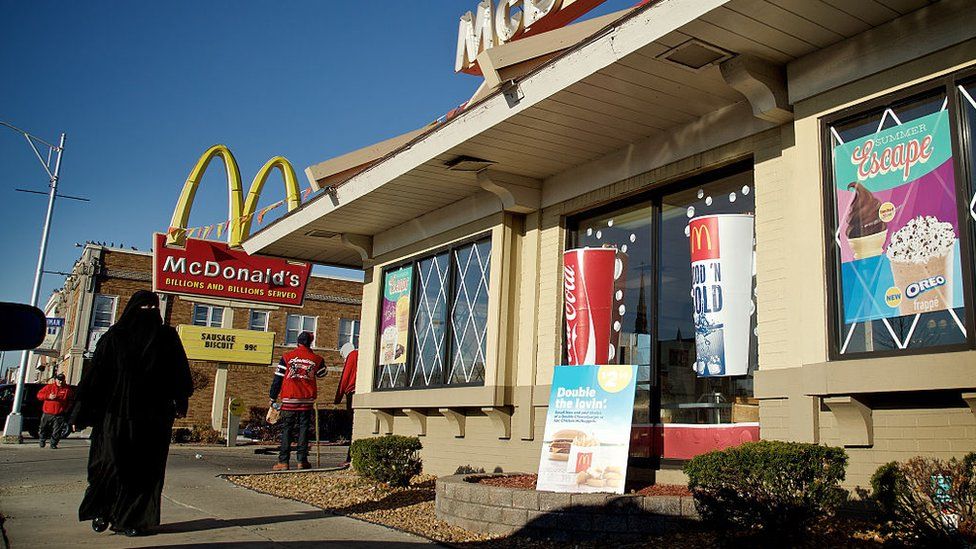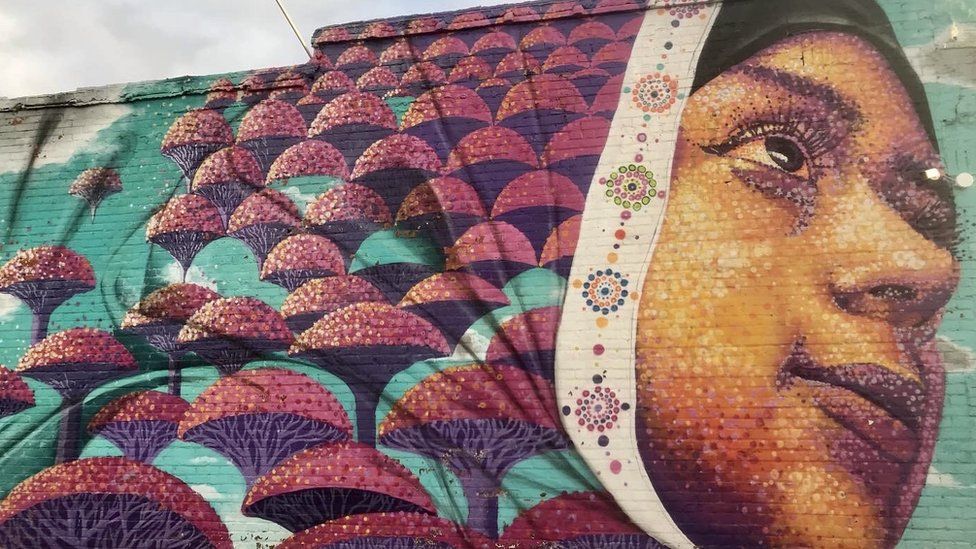The US city run by Muslim Americans
By Zhaoyin Feng
BBC News, Michigan

A walk down the main street in Hamtramck, Michigan, feels like a tour around the world.
A Polish sausage store and an Eastern European bakery sit alongside a Yemeni department store and a Bengali clothing shop. Church bells ring out along with the Islamic call to prayer.
“The world in two square miles” – Hamtramck lives up to its slogan, with around 30 languages spoken within its 5 sq km area.
This month, the Midwestern city of 28,000 has reached a milestone. Hamtramck has elected an all-Muslim City Council and a Muslim mayor, becoming the first in the US to have a Muslim-American government.
Once faced with discrimination, Muslim residents have become integral to this multicultural city, and now make up more than half its population.
And despite economic challenges and intense cultural debates, residents in Hamtramck from different religious and cultural backgrounds coexist in harmony, making the city a meaningful case study for America’s future of rising diversity.
But will Hamtramck be an exception or a rule?

The arc of Hamtramck’s history from beginnings as a town of German settlers to the modern day – it was America’s first majority-Muslim city – is etched in its streets.
Storefronts display signs in Arabic and Bengali, embroidered Bangladeshi garments and Jambiyas, a type of short curved blade from Yemen, are seen in store windows. Muslim residents queue up to buy paczki, a kind of custard-filled Polish doughnut.
“It’s not unusual to see some with miniskirts and tattoos and some in burqas walking on the same street. This is all about us,” said Zlatan Sadikovic, a Bosnian immigrant who owns a café in downtown Hamtramck.
 IMAGE SOURCE,GETTY IMAGES
IMAGE SOURCE,GETTY IMAGESA stone’s throw outside Detroit, which partly envelops the city, Hamtramck was once part of the epicentre of America’s automotive industry, dominated by the General Motors plant that straddled its border with ‘Motor City’. The first Cadillac Eldorado rolled off the assembly line in Hamtramck in the 1980s.
Over the course of the 20th Century, it became known as “Little Warsaw”, as Polish immigrants flocked in for the blue-collar jobs. The city was one of the stops of Polish-born Pope John Paul II’s US tour in 1987. In 1970, as much as 90% of the city was of Polish origin.
However, that decade saw the beginning of the long decline of US car manufacturing, and younger, wealthier Polish Americans began moving to the suburbs. The change made Hamtramck one of Michigan’s poorest cities, but the affordability attracted immigrants.
Over the last 30 years, Hamtramck transformed again, to become a landing pad for Arab and Asian immigrants, notably those from Yemen and Bangladesh. A significant portion of the city’s residents today – 42% – are foreign born. More than half are believed to be practising Muslims.

The newly elected government’s makeup reflects the changing demographics in Hamtramck. The city council will include two Bengali Americans, three Yemeni Americans and a Polish-American convert to Islam.
Winning 68% of the vote, Amer Ghalib will be the first Yemeni-American mayor in the US.
“I feel honoured and proud, but I know it’s a big responsibility,” Mr Ghalib, 41, said.
Born in a village in Yemen, he moved to the US when he was 17, first working in a factory making plastic car parts near Hamtramck. He later learned English and received medical training, and now works as a healthcare professional.
Rather than being a “melting pot” or “salad bowl”, Hamtramck is more like a “seven-layer cake” where different groups retain their distinct cultures while closely co-existing with each other, said city councilmember-elect Amanda Jaczkowski. “People are still proud of their culture specifically, whereas if it’s assimilation, we would lose the uniqueness.”
“When you live this close to each other, you are forced to overcome those differences,” Ms Jaczkowski, 29, said.
But Hamtramck “is not Disneyland”, said Karen Majewski, the outgoing mayor who will have served in office for 15 years before stepping down. “It’s just a small place. And we do have conflicts.”
Friction arose in 2004 following a vote to broadcast the Islamic call to prayer in public. Some residents have argued that a ban on bars near mosques hurts the local economy.
 IMAGE SOURCE,COURTESY OF AMANDA JACZKOWSKI
IMAGE SOURCE,COURTESY OF AMANDA JACZKOWSKISix years ago, when it became the first American city to elect a Muslim-majority government, press from all over the world descended upon Hamtramck. Some media reports at the time painted a picture of a “tense” town with an influx of Muslims. A national TV anchor asked whether Ms Majewski was afraid of being mayor.
There was even speculation from some that a Muslim-controlled city council might impose Shariah law.
“In Hamtramck, people roll their eyes at that kind of talk,” said Ms Majewski.
She was “gratified” that Hamtramck has been a welcoming community, she said, and it’s “natural” for new residents to vote for those who understand their experience and their languages.

The US Census Bureau does not collect information about religion, but the Pew Research Center think tank estimates that there were about 3.85 million Muslims living in the US in 2020, making up about 1.1% of the total population. By 2040, Muslims are projected to become the second largest religious group in the US, after Christians.
Despite their growing presence, Muslims in America have often been subjected to prejudice.
 IMAGE SOURCE,GETTY IMAGES
IMAGE SOURCE,GETTY IMAGESTwenty years after the 9/11 attack, Islamophobia still haunts Muslims and other Arab Americans. Close to half of Muslim-American adults told Pew in 2016 that they had personally experienced some form of discrimination, when the then-candidate Donald Trump proposed a ban on immigrants from Muslim-majority countries entering the US. Researchers also found that among all religious groups, Muslims still face the most negative views from the American public.
More than half of Americans say they do not personally know any Muslims, but those who personally know a believer are less likely to think that Islam encourages violence more than other religions.

Hamtramck is a living example of how personal knowledge curtails Islamophobia.
When Shahab Ahmed ran for city councilmember shortly after the 9/11 attack, he faced an uphill battle.
“There were flyers all over the city saying I am the 20th hijacker that didn’t make it to the airplanes,” the Bengali American said. After he lost the election in 2001, Mr Ahmed knocked on neighbours’ doors to introduce himself. He was elected two years later, becoming Hamtramck’s first Muslim city official.
Since then, support for the Muslim community has grown in the city.

In 2017, when the Trump administration imposed the entry ban, residents came together to protest.
“In a way it mobilised and unified a lot of people because everybody knows that in order to live in Hamtramck, you have to respect other people,” said Razi Jafri, co-director of documentary film “Hamtramck, USA”.
Nationally, Muslim Americans have also become more politically visible. In 2007, Minnesotan Democrat Keith Ellison became the first Muslim congressman. The current US Congress has four Muslim members.
On Hamtramck election day this month, dozens of residents gathered in front of a polling station to greet each other, many showing off their Election Day souvenir, the “I voted” sticker.
Immigrants were excited to participate in democracy, Ms Jaczkowski said. “It’s a very American thing to be able to bring people together”.

But as with the rest of the country, intense cultural debates are taking place in the city.
In June, when the city government approved flying a gay pride flag in front of the city hall, some residents were incensed. Several pride flags hanging outside of private businesses and homes were torn down, including one outside of a vintage clothing store downtown owned by Ms Majewski. “That sends a really alarming message to people,” she said.
Marijuana has also become a source of controversy. Three dispensaries opening in Hamtramck have prompted dismay from some in both Muslim and Polish-Catholic communities.
Other residents are concerned about a lack of women’s political participation in conservative Muslim communities.
On election night, Mr Ghalib, the mayor-elect, was surrounded by a jubilant Yemeni-American crowd in a post-election party serving baklava and kebabs. More than 100 supporters were there, all of them men.
Women participated in his campaign, Mr Ghalib said, but segregation of the sexes remains traditional, even as it is being challenged by younger generations who have become more “Americanised”, he said.
Hamtramck also faces challenges common to Rust Belt cities, from decayed infrastructure to limited economic opportunity. Heavy rains over the summer overwhelmed the city’s sewers and flooded many homes. High levels of lead were found in city drinking water samples, garnering national attention. Nearly half of the city is below the poverty line. These are just some of the pressing issues that the new city leadership would have to grapple with.
“What does democracy look like in a Muslim majority city? Like everywhere else, messy and complicated,” said the documentary filmmaker Mr Jafri, “So when the novelty wears off, the work needs to be done.”
Number of View :1503














